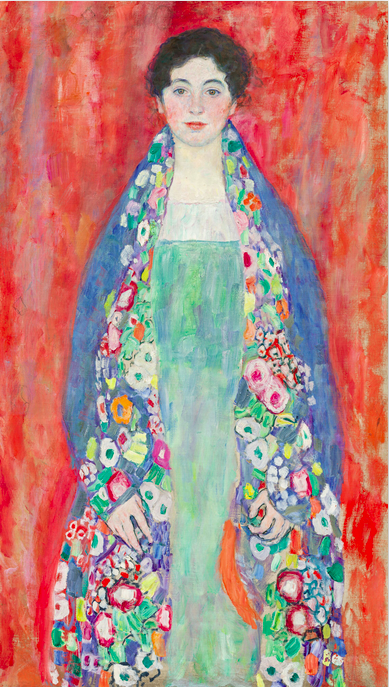“In Brief: Klimt Sale Between Record and Disappointment; Max Pechstein in Global Top 100”
[03 May 2024]Between record and disappointment, Gustav Klimt’s Portrait of Miss Lieser
All eyes converged on Vienna on April 24th, eager to attend an exceptional auction, that of the “Portrait of Miss Lieser” (Bildnis Fräulein Lieser), one of the most magnificent testimonies of Gustav KLIMT‘s last creative period. After a century of mysterious absence, this enigmatic work finally surfaced, eliciting wonder.
A rare masterpiece on the art market, the supposed portrait of Miss Lieser (the model’s identity remains enigmatic) presents a serene figure, dressed in a coat richly adorned with flowers, captured with striking naturalistic sensitivity. In other parts of the painting, we discover the pictorial freedom of a Klimt at the height of his art.
 Expectations were high for this exceptional work; however, the high estimate of 53 million dollars seemed cautious compared to Klimt’s recent records, notably the 108.7 million dollars obtained in June 2023 for “Dame mit Fächer” (1917-1918). Ultimately, the “Portrait of Miss Lieser” was auctioned in the lower range of the im Kinsky house’s estimate, for 32 million dollars, to a private collection in Hong Kong, HomeArt. The purchaser has committed to making the work available to the Belvedere Museum in Vienna for three months, thus offering privileged access to the Austrian public, which already houses Klimt’s famous “The Kiss”.
Expectations were high for this exceptional work; however, the high estimate of 53 million dollars seemed cautious compared to Klimt’s recent records, notably the 108.7 million dollars obtained in June 2023 for “Dame mit Fächer” (1917-1918). Ultimately, the “Portrait of Miss Lieser” was auctioned in the lower range of the im Kinsky house’s estimate, for 32 million dollars, to a private collection in Hong Kong, HomeArt. The purchaser has committed to making the work available to the Belvedere Museum in Vienna for three months, thus offering privileged access to the Austrian public, which already houses Klimt’s famous “The Kiss”.
The tumultuous fate of the “Portrait of Miss Lieser” has been overshadowed by uncertainties surrounding its provenance. According to the newspaper Der Standard, archive documents kept in an Austrian museum suggest that the canvas may have been entrusted by Lilly Lieser to a member of her staff before disappearing during the deportations at the end of 1943. Later reappearing in the hands of a Nazi merchant, it would then have been passed on to his daughter, and then to distant relatives. However, for the im Kinsky house, this theory remains one among others, especially since none of the three descendants of the Lieser family, all of whom survived, ever claimed the canvas, unlike other family assets.
Although the “Portrait of Miss Lieser” has been tainted by the shadows surrounding its provenance, this sale remains significant, marking the return of a major work to the artist’s home country and establishing a historic record for the Austrian art market.
Max Pechstein: Abend in der Düne, a pivotal canvas from 1911
In just one year, German artist Hermann Max PECHSTEIN (1881-1955) achieved three exceptional auction sales, each surpassing two million dollars. The latest, “Abend in der Düne”, auctioned for 3.1 million dollars at Christie’s London in March, ranks as the artist’s fifth highest-selling work at auction, propelling Pechstein into the top 100 performing artists globally for the first quarter of the year.
 This oil on canvas was created in an extraordinary burst of creativity during the summer of 1911, as Pechstein, recently married, spent the summer with his new wife, Lotte, in the Baltic fishing village of Nidden. The paintings made by Pechstein during this memorable summer mark a pivotal moment in his career as an artist, a significant evolution from the already radical paintings of figures in nature he had created the previous summer.
This oil on canvas was created in an extraordinary burst of creativity during the summer of 1911, as Pechstein, recently married, spent the summer with his new wife, Lotte, in the Baltic fishing village of Nidden. The paintings made by Pechstein during this memorable summer mark a pivotal moment in his career as an artist, a significant evolution from the already radical paintings of figures in nature he had created the previous summer.
“Abend in der Düne” is one of the most ambitious and accomplished paintings of 1911. Depicting four nude female figures living collectively in a warm and seemingly exotic environment, it draws inspiration from earlier bathers paintings by Cézanne and the Fauves, particularly imitating the aspirations of Paul Gauguin’s Tahitian period. The pose of the central figure notably recalls Gauguin’s “Tahitian Women Bathing”, now exhibited at the Metropolitan Museum of Art in New York.
Displayed at the New Secession in Berlin and then at the Paul Cassirer gallery, the works of 1911, including “Abend in der Düne”, solidified Pechstein’s reputation as one of the leading representatives of the Brücke aesthetic in the city.





 0
0
